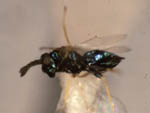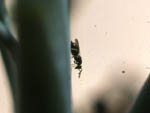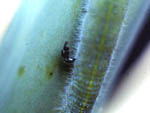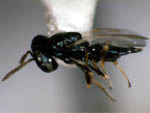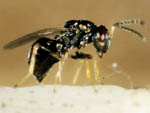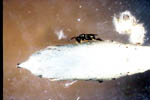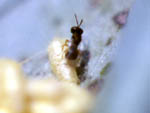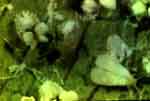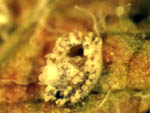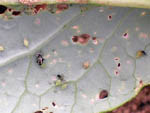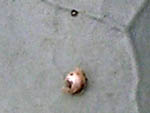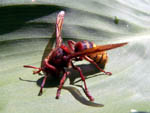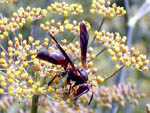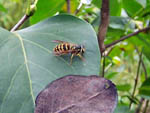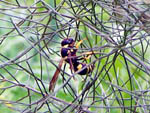Ladybugs |
Parasitic Wasps |
Predatory Flies |
Predatory Bugs |
Lacewings |
Predatory Beetles |
Mantids |
Spiders |
Dragonflies |
Parasitic Wasps
Order Hymenoptera
|
Parasitic wasps: Identification: Parasitic wasps are generally small (an inch or less long, and most are less than 1/4 inch long) slender, hairless flying insects with 2 pairs of clear to smoky membranous wings and long antennae. Many are black or brown, but some have intricate color patterns. Their size is generally based on the size of their host; e.g. Cicada killer wasps are huge (2 inches or longer), and Trichogramma wasps are the size of the period at the end of this sentence because that is the size of the insect eggs that they attack. Female parasitic wasps usually have a readily visible ovipositor. Most parasitic wasps attack a specific host, such as a caterpillar, or butterfly/moth egg or pupa, beetle egg/larva/pupa, cicada, or other insect eggs, larva or pupa. This specificity of hosts allows you to make sure you have the right wasp present when the hosts (caterpillars, beetles, etc.) show up. Dispersion by size (and by habits of the host) - small wasps (Aphelinids, Aphiids, Trichogrammatids, Mymarids, Scelionids) stay in field; medium wasps (smaller and medium sized Braconids, Ichneumonids, Eulophids) forage less than 1/4 mile if food/hosts present; larger wasps (Bigger Ichneumonids, Tiphiids, Scoliids, plus predatory wasps like paper wasps and hornets) travel more than 1/4 mile in search of food and hosts.
1) Braconids - adult wasps are usually smaller than ichneumonids (less than 1/4 inch) and of more compact build, with long antennae and clear to smoky colored wings. They usually have less than 15 antennal segments. They sting their prey and deposit an egg(s) in the host. Braconids are cocoon makers in the pupal stage, so they can be found on the crop, or nearby plant leaves in fields - cocoons can be single or multiple - yellow or white, usually. If they are fresh, the host cadaver may still be nearby, which can tell you what species of wasp is attacking. These wasps are very important parasites of caterpillars - get them going early to ride herd on pest worms. These wasps like flowers with small, open nectaries, like wild carrot flowers (umbels). Many parasitic wasps will also host-feed - they will drink the hemolymph (blood) of the host as a way of getting protein, too. Overwintering plants are yarrow and comfrey. Leave some crucifers, like broccoli standing or to the side, as many braconids overwinter as cocoons on dead broccoli plants or similar mustards.
2) Ichneumonids - Slender, larger (1/4 inch or larger - bigger than braconids) wasps with long legs, long antennae (-more than 15 antennal segments), and long ovipositor. Ichneumonids and braconids are some of the most important parasitic insects. Ichneumonids make cocoons usually inside the host, so you might see a caterpillar skin over an oval black and white striped cocoon (Hyposoter spp.). Or, they use their long ovipositor to bore through plants or wood and sting the larval (like caterpillars or beetle grubs) or pupal hosts inside. Their sting paralyzes their prey temporarily, and allows the female to deposit an egg(s) in or on the host. These wasps are also, like braconids, very important parasites of caterpillars - get them going early and preserve their populations to ride herd on pest worms. They also like umbels and similar flowers that have open nectaries. Same overwintering plants as braconids - yarrow and comfrey, and leave crucifers or similar crop plants as winter harborage.
3-4) Tiphiids/Scoliids - Identification: Large; look similar to carpenter ants with wings, but quicker and more serpentine. Tiphiids are solid black, and Scoliids have various color patterns - yellow/black, brown with 2 orange spots, etc. If you handle them, the females can give a mild sting. Adult female wasps burrow into the ground to attack grubs - specific wasps for Japanese beetle grub, Oriental beetle grub, Green June beetle grub (Scoliid); etc. They sting the grub, paralyzing it. The wasp then lays an egg on the grub, which hatches and consumes the grub in a week or so. It then spins a brown cocoon in the soil about the size of a small peanut. Wasps overwinter in the cocoon stage below ground. All of these wasps are VERY dependent upon food plants and/or aphid honeydew to realize their high reproductive potential. The spring Tiphia, Tiphia vernalis Rohwer, attacks Japanese/Oriental beetle grubs in April/May. Important food plants for the Spring Tiphia are Tulip poplar, peonies, pyracanthas, forsythia, and plants with aphids for honeydew. Tiphiid/Scoliids also host feed by biting the leg of a grub and drinking the hemolymph that exudes from the wound.The spring Tiphia, Tiphia vernalis Rohwer, attacks Japanese beetle grubs in April/May. Or goto www.oardc.ohio-state.edu/biocontrol/ Click here to see the Tiphia video
8)Eulophids - Small to medium sized wasps, usually metallic green or blue. Some are parasitic on pest beetle eggs, like Edovum puttleri against Colorado potato beetle eggs. They have been shown to kill as many eggs through host feeding as they parasitize! They like umbels and similar open flowered plants, like yarrow. Some Eulophids are hyperparasites of the parasitic wasps attacking imported cabbageworm (Tetrastichus galactopus attacking Cotesia glomerata/rubecula/orobeanae).
9) Pteromalids - Pupal parasites of caterpillars and beetles, primarily. Identification: Very small (less than 1/8 inch); black with red eyes. Females have the ovipositor attached on the underside at the front end of the abdomen. Ovipositor has saw-like blades to drill into host. Females usually lay around between 10 and 50 eggs or so in a host pupa, depending upon the size of the pupa.
10) Encyrtidae - Encarsia spp. and others.
11) Aphelinids/Aphiids- I want my mummies! These wasps sting aphids and produce the brown aphid mummies you see in the field. The whitefly parasite Encarsia Formosa is a very important mortality factor against the greenhouse whitefly, and is in commercial production. If you look closely, you may see the exit hole of the wasp, usually at the rear of the aphid or whitefly mummy. Count mummies versus non-mummified aphids to get a handle on percent parasitization. Research has shown that Aphelinid populations generally are isolated in fields, and that nearby populations 1/4 to 1/2 mile away are genetically isolated from one another. So, these don't move much and are dependent upon very localized sources of food for energy and mating sites. Trick: Keep greenhouse temperatures above 76 degrees, and Encarsia can out-reproduce the whitefly by twofold. Plus,
12) Predatory Wasps - Hornets, Paper Wasps, Yellow jackets,
etc. Social insects that are best kept slightly away from your areas
of most activity. They like to nest in overhangs or protected areas.
They are okay if they are out of the way; otherwise, it is no fun to
be chased out of your patch by bald-faced hornets. They forage over
a large area, greater than 1/4 mile. Many will feed on caterpillars
or similar soft-bodied insects. Predatory wasps will supplement their
prey feeding with nectar and pollen from umbellifera, goldenrods, cilantro,
sunflowers, and other pollen producing plants. They overwinter as mated
queens in your house or outbuildings. Knock down undesirable nests early
by blasting them with water or soapy water to kill them.
|
||||||||||||||||||||||||||||||||||||||||||||||||||||||||||||||
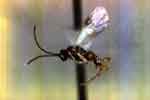

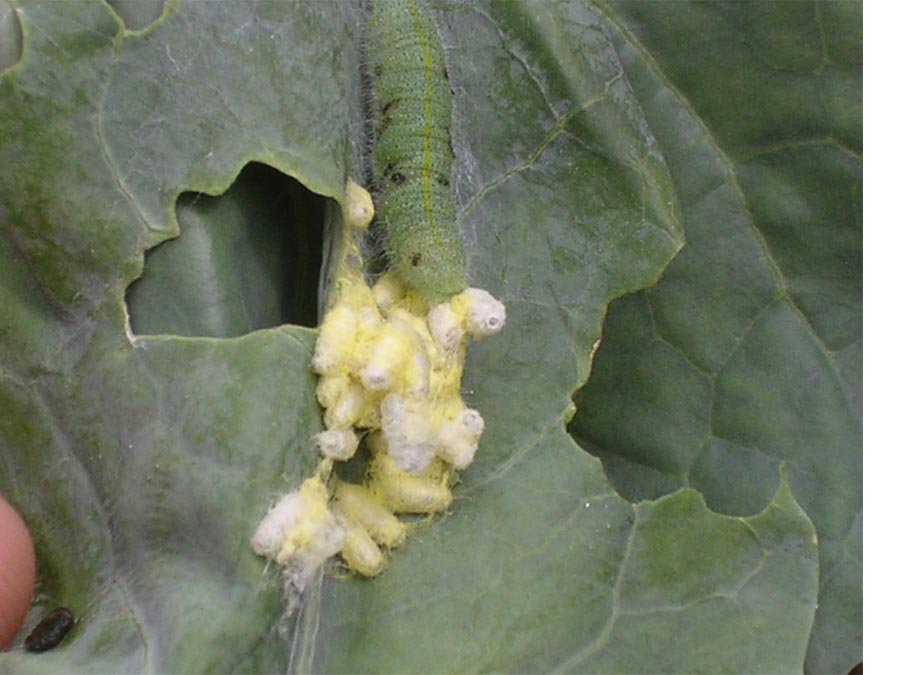
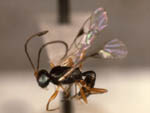
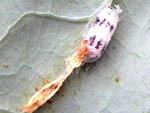
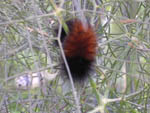
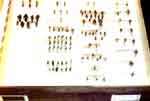
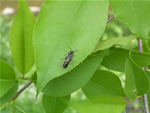
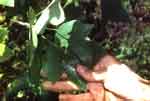
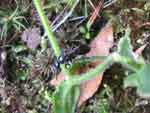
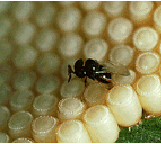 5-7)Trichogrammatids/Mymarids/Scelionids - tiny wasps about
the size of the period at the end of a sentence. Trichogrammatids and
Mymarids (Fairyflies) can be important parasites of the pest eggs of
imported cabbageworm, gypsy moth, cabbage looper, cereal leaf beetle,
and other pest insect eggs. A somewhat similar family of wasps with
similar habits is the Scelionidae - egg parasites of Stinkbugs. Because
of their small size, you need a dissecting microscope or a 10X minimum
ocular to see them well. They like the small, open nectaries of flowers
such as umbellifera, bridal wreath spirea, and yarrow. So you need lots
of little clumps of farmscaping plants all over for these guys.
5-7)Trichogrammatids/Mymarids/Scelionids - tiny wasps about
the size of the period at the end of a sentence. Trichogrammatids and
Mymarids (Fairyflies) can be important parasites of the pest eggs of
imported cabbageworm, gypsy moth, cabbage looper, cereal leaf beetle,
and other pest insect eggs. A somewhat similar family of wasps with
similar habits is the Scelionidae - egg parasites of Stinkbugs. Because
of their small size, you need a dissecting microscope or a 10X minimum
ocular to see them well. They like the small, open nectaries of flowers
such as umbellifera, bridal wreath spirea, and yarrow. So you need lots
of little clumps of farmscaping plants all over for these guys.